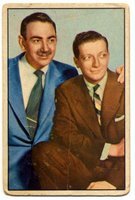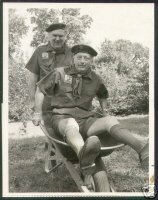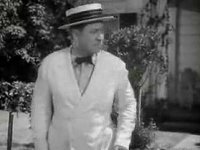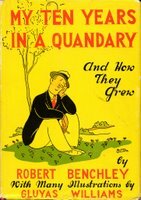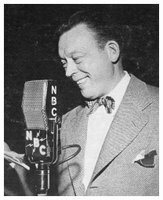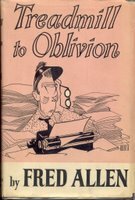The post before this one has a Bob Elliott appearance on David Letterman. Bob Elliott occasionally did a pretty passable Peter Lorre impression – so here’s a great clip of Bob’s son Chris attempting to imitate another famous horror icon: Jay Leno.
|
|
|||
|
- The historian for the Democratic party (a wonderful switch on the Komodo Dragon Expert routine) You can hear, as always, Carson laughing in the background… and the Tonight Show audience loves it! 11m
I had the extremely good fortune to work with Bob and Ray on an industrial video taped at the old 23rd Street HBO studio, and in the run-up to the taping, I visited B&R in their office at the Greybar Building. I will never forget the sight: as you walked in, towards the back of the Butter ‘em on the far side and write if you get work.
It’s an entertaining segment in which Messrs. Elliott and Goulding have a chat with Dick Cavett about two comedy heroes shared by all three men – Robert Benchley (in the white suit) and Fred Allen. The discussion is followed by a terrific Wally Ballou interview with one of Bob and Ray’s lesser-known characters, Mr. Wwqlcw. Watching this clip sent me back to my Benchley books. My White Suit is a piece collected in My Ten Years In A Quandary And How They Grew (1936). I also pulled Fred Allen’s Treadmill to Oblivion (1956) off the shelf and started reading bits and pieces at random. This led me to change my mind about… well, I don’t want to get ahead of myself. First, enjoy the clip: Benchley’s short film That Inferior Feeling (1940) is all about feeling ill at ease in situations where there are no real reasons to feel ill at ease. And despite the promises of the ask-your-doctor ads, no amount of Paxil or Prozac will alter the clothing-purchase experience for those who find it painful. There are still many men who experience great relief each time they exit a store without being Those of us who admire entertainers of yesteryear often have a tendency to drift along with the undercurrent of melancholy that is the wake of the public’s fickleness in its never-ending search for new amusements. Younger fans who missed the heydays of their idols often make substantial efforts to seek out the portion of the work that survives, then use it to proselytize on behalf of their hero. They shake their heads sadly when few join them in their celebration of those who reached incredible heights of popularity in their own day… only to arrive at a near-total indifference and anonymity in ours.
Hero worship can be equal parts adulation and sympathy. Adulation and sympathy not just for the hero, whose greatness was once – but is not currently – recognized; but also adulation and sympathy for one’s self, as a person both blessed and cursed with the capability to perceive and champion criminally overlooked genius.
Like Benchley’s man in a white suit who can’t help feeling ill at ease in non-threatening situations… like the law-abiding citizen worried about the security guard’s suspicions… there’s no good reason to feel bad for comedians and other successful entertainers who connected strongly with the audience of their day but are now largely forgotten. Neither should we feel sorry for those who can’t, today, appreciate an old Fred Allen radio show or Robert Benchley short. Few can. And we should never, under any circumstances, make it our mission to convert the heathens who will not acknowledge, let alone bow down before, the old gods some of us still worship. Because truth be told, the treadmill never actually reaches oblivion. As in Zeno’s paradox, there’s always another halfway point ahead, a halfway point where fewer remember, fewer enjoy, fewer care. Between 1932 and 1949, Fred Allen built up an average speed on that treadmill. As soon as he got off, that average speed started to decline. But it never quite reaches zero.
A little over 31 years after this book was published, a detective/mystery radio show debuted on the Blue Network: Mr. Keen, Tracer of Lost Persons. The show was wildly popular, running from 1937 through 1955. But the show is always credited to Frank and Anne Hummert, whose forte was soap operas – Ma Perkins, Stella Dallas, and Mary Noble, Backstage Wife. Was this book the beginning of Mr. Keen? After all, the show opening said something about “the famous fictional character,” but the closing said the show was “based on the novel Mr. Keene.” Even so, this has to be him, right? Not the cover picture, obviously, but in the pages inside.
Page one, but the name “Mr. Keen” does not appear. The Hummerts paid writers little, churned out thousands of episodes of dozens of series, and and were hardly ever mistaken for creators of art… or even nice people. Did they rip off the idea for Mr. Keen from a 31 year-old book? Did somebody else? I’d never seen or heard of this tome before.
It’s page two. Still no Mr. Keen, although we have a “Mr. Kerns.” Were the Hummerts so lazy that they named their rip-off radio character by changing two lousy letters from the second name mentioned in “Tracer of Lost Persons?” Page three. Gatewood meets Kearns. Nothing. Page four.
No Mr. Keen on page four. No Mr. Keen on page 5.
I’m surprised that the Hummerts never created a soap opera called “Between Heaven and Hoboken.” Great title. I plunge onward to page 6. The dandy Gatewood is now sprinkling French words and phrases into his utterances. OK, but… Wait! Page 7:
Sorry to have ever doubted you, Hummerts. Mr. Keen himself does not show up until page 17:
I’m about 60 pages in by now, and so far, there is no physical description of Mr. Keen. I don’t think a description is forthcoming – the book is a series of vignettes more focused on Mr. Keen’s clients than Mr. Keen himself. We do not know how Mr. Westrel Keen (radio historians who say “we don’t know his first name” are wrong!) acquired his amazing ability to find lost persons. We do not know what he looks like, unless we credit the book’s illustrations. If there was a radio series based on this guy, it should have been The Shadow. The radio series lasted forever, but very few people think it was much good. The Encyclopedia of Old-Time Radio describes it as “a prime-time mystery with serious soap opera trappings,” pointing out that “…the dialog was simplistic, identifying each speaker and subject fully in each utterance: ‘Before I open this door, Mr. Keen, let me tell you something. No one in this house right now had anything to do with the murder of young Donald Travers, my niece’s husband.’” Not until Judson Fountain came along were the Hummerts topped in dramatic character-based explication of the obvious (“See this? If you don’t know what it is, I’ll tell you. It’s a gun.”) Listen to all or part of an episode of Mr. Keen, Tracer of Lost Persons (30m), because it will help you more fully appreciate the brilliant satire of Bob and Ray’s Mr. Treat, Chaser of Lost People (7m). |
|||
|
For the record: We don't believe life is terrible. We believe that isntlifeterrible is a memorable website domain name. |
|||
